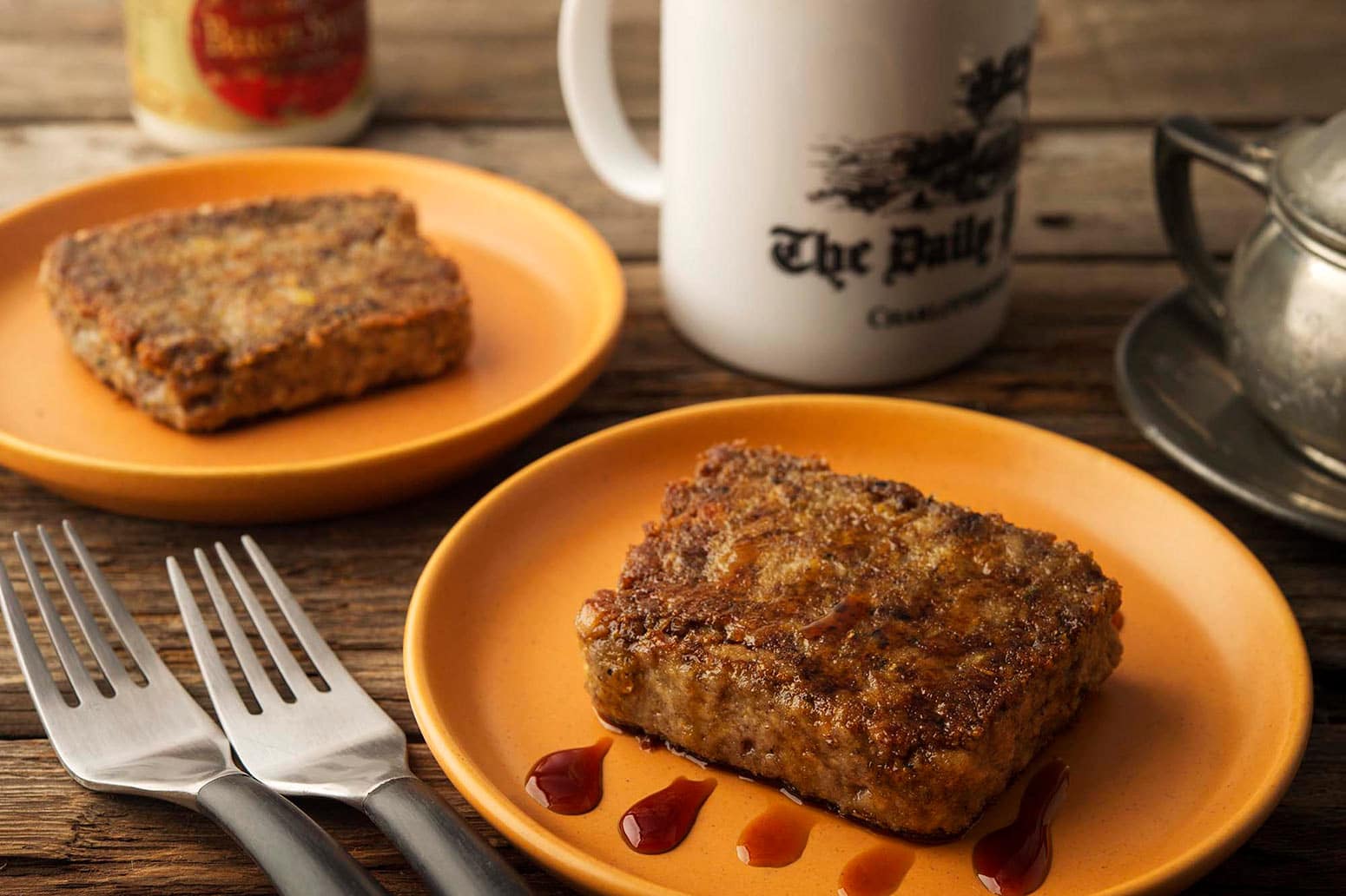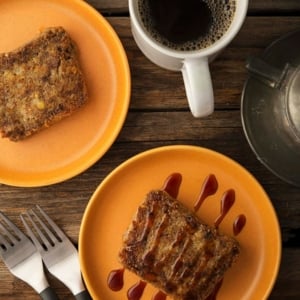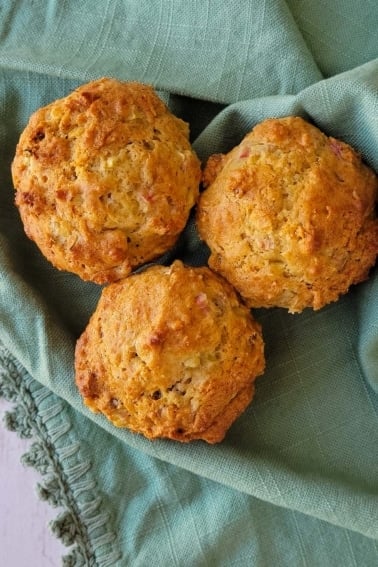As an Amazon Associate I earn from qualifying purchases.

Scrapple. Mystery meat. Lips and, well, scraps. Scrapple is scorned by many, loved by those who know.
Yes, industrial scrapple literally used to be made from scrapings off the killing room floor. Ew. But any homemade scrapple recipe uses bits that are far more wholesome.
First off, what is scrapple? It is a hybrid meatloaf-sausage common in the mid-Atlantic states, notably Delaware, Maryland and Pennsylvania, but I’ve eaten it as far west as Peoria, Illinois. It’s there that I first had scrapple I liked.
I grew up in New Jersey, in the heart of Taylor ham country. Taylor ham is the single greatest breakfast meat ever made, but then I am biased. When you live in Taylor ham country, you look down on scrapple, so I never ate it as a kid. Then, one day, I ran a 10k road race in Peoria. Afterwards, I could eat anything I was so hungry. So I ordered the scrapple.
It was served with apple butter and maple syrup, and I could choose. I thought it weird, but then, I like maple breakfast sausages, so why not? And damn it if it wasn’t tasty!
Scrapple tastes meaty and porky, peppery with warming spices and that softness you get from good polenta. Good scrapple is very crispy on the outside, soft in the center.
Flash forward some time, and I found myself with a pig’s head. This an oddly common occurrence in my household.
I’d already made a fantastic pozole with one head, as well a French fromage de tete and an Italian version of head cheese, so I was looking for something to make that was different. Why not make scrapple?
Scrapple recipes are all over the map. Southern versions use only pork and cornmeal, but mid-Atlantic ones use buckwheat flour, too. In Ohio, you see goetta, which uses oats. This is a Pennsylvania-style scrapple.
A truly authentic scrapple recipe use a pig’s head, and that’s what I used here. But you need not go that far if you really love scrapple. You can make it with any assortment of random pig bits. But keep in mind that scrapple has to bind to itself, so you want that collagen that is in a pig’s head.
You could sub in pig’s feet, or even use a sheet of unflavored gelatin in a pinch.
Scrapple takes time to make, so make your scrapple on a weekend or day off. It also needs to rest overnight in the fridge to set up. Once made, however, scrapple will keep for a week in the fridge, and it freezes well.
To serve, cut off thick slices from the loaf, dust in flour or fine cornmeal, then fry in butter, lard or bacon fat. Eat it solo, or with apple butter or a nice dark syrup.
Scrapple
Ingredients
FOR THE PIG'S HEAD
- 1 pig's head, with or without the jowls
- 3 carrots, chopped
- 1 large onion, chopped
- 3 to 6 bay leaves
- 1 tablespoon juniper berries, crushed (optional)
- 1 tablespoon black peppercorns, cracked
SPICE MIX
- 1 tablespoon freshly ground black pepper
- 1 tablespoon salt
- 1 tablespoon savory
- 2 teaspoons Bell's poultry seasoning (optional)
- 1 teaspoon dried thyme
- 1 teaspoon ground white pepper
- 1/2 teaspoon cayenne
TO FINISH
- 2 heaping cups cornmeal
- 1/2 cup buckwheat flour
Instructions
- Set the pig's head in a large kettle and cover it with water. Bring this to a boil and skim off all the scum that floats to the surface. When this is done, add the carrots, onion, bay leaves, juniper and black peppercorns. Simmer this, adding more water if the level drops below the pig's head, until the meat wants to fall off the bone, about 3 hours.
- Carefully remove the pig's head and pick off all the meat and random bits. I toss the eyes and the palate, which aren't very tasty. Chop everything up very fine, and combine with the spice mix in a bowl.
- Strain your pig broth and pour about 10 cups into a large pot. Bring this to a simmer and add the cornmeal and buckwheat flour, stirring constantly so you don't get lumps. Add salt to taste. Cook this, stirring often, about 30 minutes.
- Add the chopped pig bits in with the mush and stir well to combine. If you happen to be using the unflavored gelatin, now is when you would add it. Let this all cook for 10 minutes or so.
- Pour this into loaf pans, or a terrine pan. While not strictly necessary, it will make the scrapple easier to remove if you line the pan with plastic wrap first. Pack it in well. Let it cool to room temperature uncovered, then cover it with plastic wrap and refrigerate overnight before slicing and frying.
Notes
Nutrition
Nutrition information is automatically calculated, so should only be used as an approximation.






Hank, thanks so much for featuring scrapple. Having been born in Lancaster County, PA, the center of Pennsylvania Dutch country, I learned to like scrapple and even pork pudding and fried mush from my childhood days. I laud your interest in making food ourselves; I have made cheese and scrapple myself. But I also do not like to see myths continue to circulate. Have you ever worked in a meat processing plant and seen meat picked off the floor and used? I put in my time as a teenager at a chicken processing plant, and that practice was roundly forbidden.
Richard: Now, yes. But historically all sorts of awful stuff happened, mostly in industrial meat processing. Admittedly, I am betting what I am talking about is what happened many decades ago, a la Upton Sinclair’s The Jungle…
Might ham hocks work? Also, would acorn flour make a decent substitute for the buckweat?
Tim: Yes, if the ham hocks are not smoked. If they are smoked, I bet it would be tasty, but not true to the taste of scrapple. Ditto for acorn flour. That’s a great idea, by the way!
Scrapple, yea! As a central PA guy, I’ve been eating it for years. I first heard about making it on the Frugal Gourmet years ago. That recipe used pork neck bones, sage, savory lots of pepper and salt. I was unable to locate neck bones so I use chops which work just fine (never boneless!). I think it’s the spices that really come through, the pork / broth source isn’t critical. Also, it’s not as “gray” with the chops as what you get in the store but still tasty! A friend that worked in QA for a local pig processor said I should include a liver and an onion. Not being a liver guy, I just filed that thought away : )
You’re right, the collagen part is very important, hence the need to bones. I cook the broth for 4 to 6 hours. Also, I don’t bother measuring it out. After the boil I pick out the bones and meat, chop and set aside. Then with the bag of local stone ground corn meal, I start adding and stirring. It’s an eye-ball for when there’s enough cornmeal in but I’m basically looking for polenta thickness. Then at least 2T sage and 1T savory with lots of pepper. I add salt and start tasting. Maybe more sage maybe more salt. I enjoy the tasting part even when it’s still soft. Small loaf pans are nice for gifting and fitting in the freezer. It’ll keep in the chest freezer for months. One things that happens when it’s defrosted is more water comes out, I’m not sure why but I give it a gentle press and squeeze it out to make cooking a bit easier.
On cooking, pan frying has never worked well for me. No matter what I do it ends up sticking and losing the brown crust however the broiler does the trick! Cooking spray on a foil covered tray and crispy scrapple is easy!
I never heard of scrapple until I had a neighbor who hailed from Michigan. His description of the process and product made me vow to one day make a batch. Your recipe sealed the deal.
Are you using a harvested head feral swine? If so, please elaborate on the preparation.
Michael: No, but that would work. Most people would skin the head, but you could scald it with steaming water and a scraper.
Hank, My grandfather grew up in SE Ohio as the son of German-immigrant coal miners. He would make Pon Haus and I remember it fondly as a kid. I found the old recipe and made it for my Mom, Aunt and Uncle for Christmas. It was great and dead simple. It takes plenty of arm strength tho. They were a tougher generation. He’s the recipe:
2lbs of ground pork (I used bulk breakfast sausage from the processing of a wild hog. He used to use breakfast sausage as well)
1lb of buckwheat flour
Lots of ground black pepper
Gently boil the sausage in a large pot of water making sure to break up the sausage as much a possible while cooking. Remove the cooked sausage with a spider or strainer. Keep the water at a low boil.
Add the buckwheat flour and stir like hell. Use a significant spoon.
Add the sausage and black pepper to the mix and keep stirring while the mixture cooks.
Move the mixture into cake pans sprayed with a bit of water. and then move them in the the refrigerator to cool.
Once totally cooled, slice to 1/4 in pieces and fry in plenty of butter.
Do you see any issue using trotters? I like scrapple, but my wife is a bit to genteel for pigs head. I’m working on her, but I need a place to start.
JB: Nope, trotters are a good substitute, but you will also need lots of meat, too.
Do you leave the jowls on? I usually use those for jowl bacon or guanciale, but if you can use the head minus the jowls, I’m all in.
Matt: You can, but I did not. I too love jowl bacon too much to use them in scrapple.
Seems interesting. One question – are the brains in there? Or do you remove them?
Frank: Brains are in there, and there they stay. Too much effort to split the head to get at them. But if you had a split head, I’d include them in the scrapple.
Ears give a lot of collagen also. We use them when making souse. (With lemons, not vinegar. Its the Italian-American version.)
Do you include the tongue and brains into the scrapple?
David: Definitely the tongue, and brains if you can get at them.
I was born about 45 mi n of Peoria and this sounds right except that we did not have seasonings that you had to buy, except pepper.
Going to have to replenish our buckwheat flour. Also this works well with buckwheat honey if you can find it.
We made scrapple one year after canning pork. It was okay – I’m not sure I would do it again. We froze it and it is still amazingly good – froze and store beautifully. We’ve been turning it into hash to use it up and that is really good.
Thank you for sharing this — I had no idea goetta was a form of scrapple. I grew up in Ohio and as a child, I remember goetta was a real treat when served — especially for breakfast. After I graduated from college and moved away from home I longed for, but could never find goetta. In fact, no one had ever heard of it. I remember I even spent one desperate afternoon internet searching to find a recipe, with no success. Thanks for the recipe, however, I would appreciate your suggestion/recommendation for what cuts of meat that I might purchase at the supermarket to substitute for the pig’s head and… what modifications would you make to this recipe to translate it to goetta. Just swap out the buckwheat for oats maybe? Many, many thanks… from the bottom of my (food) tank and… memory bank!
Kathleen: Yes, sub rolled oats for buckwheat flour. As for cuts, feet, hocks, shanks, neck and shoulder would be my choice, maybe with a country rib or two in there.
Finaly some love for scrapple! It is the king of all the breakfast meats and the best versions are home made. I agree with Bill that the recipe is pretty basic (all good scrapple needs a healthy dose of what my PA Dutch mentor called cory-ed-na). Your slices look a bit thicker than we normally cut them – we like them about 1/4″ thick to get a better balance of crispy crust to creamy interior.
Our family has made something similar to this but oatmeal was used and it was called ponas or ponhass, I can still see that pig head cooking away in the pot. It was served with dark syrup and was delicious.
Some friends of the family have been bringing homemade scrapple to our Southeast IN deer camp for years. They simmer their Thanksgiving turkey carcass and use that instead of pork. It’s great! I’ve always wanted to try it with a pile of leftover gamebird carcasses, but I’ve never actually done it. Maybe this will be the year.
My family and now kids love scrapple. Our version, Southern Illinois, follows:
1 gallon head broth or pork broth
1 # white cornmeal
1C oatmeal
1C flour
cloves 1 t
cinnamon 1 t
ground up meat handfull or more
salt to taste
mix all dry ingredients together -slowly add to boiling broth with meat
cook until it thickens and you can make a track with the stirrer
add salt to taste
pour into loaf pans that have been moistened with water
cool -slice thin-fry —
yes it’s fattening
Nothing like looking at a pig staring up at you from the kettle. Thanks for the recipe. I’ll have to make scrapple again now.
So Hank–if a pig’s head may yet be a bit beyond the pale in my household, could you just sub in a pork shoulder or butt, chapped up fine?
Bruce: Yes, but you need collagen, so you will need feet or a sheet of unflavored gelatin.
What a Great topic and recipe. I live on a farm in NJ and we make scrapple once every winter most winters anyways. We make around 350 lbs in a batch. We have a huge caldron make just for making that. Its a recipe that has been handed down for quite some time. The process is a two day ordeal but well worth the effort. Sometime if you want to know how we do it let me know. Very basic recipe
Bill,can you send me the recipe? Thanks.
chris.